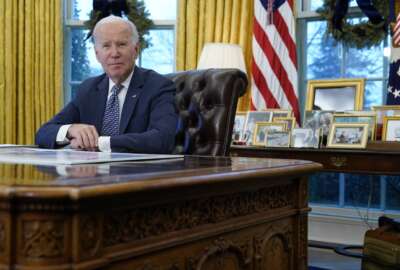
Initial plans to cap pay raise for hundreds of NSF employees gain major union pushback
The American Federation of Government Employees raised concerns about initial plans to cap pay for hundreds of employees at the National Science Foundation, tho...
Update: National Science Foundation leadership has walked back this plan, and announced that all NSF employees on the Administratively Determined pay scale will receive a 4.6% average pay raise for 2023.
Hundreds of employees at the National Science Foundation may receive a smaller pay raise for 2023 than agency workers on the General Schedule.
In an email to its staff, obtained by Federal News Network, agency leadership shared initial plans that would impact employees in the fourth bracket of NSF’s excepted service pay scale, called the Administratively Determined (AD) scale. The email announced plans for an average 1% pay raise for AD-4 employees this year, incorporating a 0.5% base pay raise, plus an average of 0.5% locality pay raise.
Employees at NSF on the General Schedule will receive the full 4.6% increase, composed of a 4.1% base pay raise and an average 0.5% locality pay raise, as the Biden administration implemented in December.
The American Federation of Government Employees, the union representing NSF workers, raised concerns about agency management’s plan to cap AD-4 employees’ pay. David Verardo, president of AFGE Local 3403, which represents NSF employees, said if the plan comes to fruition, it would be the first time NSF leadership has capped pay in this way. In the past, AD-4 employees have typically received pay parity with their counterparts on the GS scale.
“AFGE National and AFGE Local 3403 worked very hard with members of Congress and the Biden administration to make a case for a significant pay increase for all federal staff, not just bargaining unit members. That hard work paid off, except for AD-4 staff at the NSF,” Verardo said in an email to NSF leadership, obtained by Federal News Network.
There are 678 employees categorized as AD-4, 334 of which are at the top of that pay scale and would be impacted by the proposal, according to an NSF spokesperson. The AD scale at NSF is generally composed of professional science staff, and AD-4 employees are program directors, mostly running science and technical programs. NSF has 868 employees on the General Schedule, according to data from the Office of Personnel Management.
NSF also has 95 employees in the Senior Executive Service. Of those senior staff, 80 career SES employees received annual bonuses, with an average bonus amount of $20,853 per employee, totaling $1,689,091 across the 80 members.
For staff paid through an excepted service pay scale, such as the AD scale, an agency can set wages for the employees based on what it believes is necessary to effectively recruit and retain the workforce. In 2021, AD-4 employees at NSF made between $148,933 and $190,947.
Senior officials at NSF sent out the initial plan to cap the AD-4 pay raise, as a way to maintain a distinct pay gap between AD-4 employees and career SES employees.
“As we look to address equity issues agency-wide, we discovered a lack of pay difference between the AD, SES and GS pay scales. Both GS and SES pay scales have a pay cap, while the AD scale does not. Even members of Congress and the NSF director have caps on pay. If no action were taken, some on the AD scale would be receiving higher pay than many in these categories. The decision was made to remedy that imbalance,” NSF Chief Operating Officer Karen Marrongelle said in an email to NSF staff, obtained by Federal News Network.
But an NSF spokesperson told Federal News Network that no final decision has been made, and the current focus from leadership is to correct “inaccurate information prematurely shared with staff.”
“NSF leadership values all employees equally no matter what position, pay plan, rank or role they serve in. Our workforce is our most important asset, and we cannot accomplish our mission without them,” the spokesperson said in an email to Federal News Network.
Notably, some career federal employees in the General Schedule experience pay compression once they hit the GS-14 and GS-15 levels. Career SES employees hit a pay ceiling at the upper end of the GS scale, since according to federal statute, salaries for GS career employees cannot exceed pay rates for political appointees and others at level IV on the Executive Schedule.
Still, the agency’s decision to cap AD-4 pay left many NSF employees upset, angry and frustrated.
“What I see as another issue here is that there are AD-4 staff, including myself, that are still within the GS-14/15 pay range. I don’t see why a GS-15, who makes more than I do, deserves a pay increase and I do not. Was there any discussion of the fact that many AD-4 employees are currently within the pay band of GS-14s and 15s? From my perspective, [management’s] reasoning does not make sense based on the wage gap explanation,” one NSF employee wrote in an email to the union.
Verardo added that the disparity between pay for AD-4 and SES employees is “arbitrary,” and noted that this management decision only exacerbated underlying issues of trust, and sense of betrayal by staff, toward agency leadership.
“[Management] feels that SES should not only be distinct, but that they need to be distinct based on their salary. It’s hard to understand, and it’s definitely hard to swallow,” Verardo said in an interview.
Verardo added that there’s no shortage of employees interested in joining the SES at NSF — and pay isn’t necessarily the reason AD-4 employees choose whether or not to move over to SES.
“People want to move in and move up into different parts of the organization to experience NSF differently,” Verardo said. “Salary is not the issue that really defines that move; they just want to serve differently and get a new experience.”
One alternative option, according to Verardo, would be to at least phase in the pay cap for AD-4 employees, rather than instituting it all in one year.
NSF leadership held a town hall for staff on Jan. 31 to discuss the issue, which garnered broad employee attendance, with hundreds attending both in person and virtually. The NSF spokesperson said the listening session with AD employees gave leadership valuable feedback.
“Whether we move forward with the proposal that has been shared with our staff prematurely or go another route, this issue will need to be addressed for the long-term,” the spokesperson said.
Verardo noted that AD pay is particularly important, given NSF’s significant budget increases to expand its STEM portfolio, which scientific staff in the AD ranks are the main workers on.
“The AD staff work at the very foundation of NSF’s mission to promote the progress of science by running the essential NSF merit review system. Without science staff, there is no mission for NSF,” Verardo said in an email.
Many NSF employees have expressed concerns with NSF’s decision to cap AD-4 pay, with some calling it “quite a betrayal,” “so frustrating,” and a “breach of trust.”
“The reason for making such a distinction in salaries between the SES management and AD program directors is not only insulting, but it will also likely result in reduction of intellectual leadership from program directors,” one employee wrote. “Deeming them as less worthy of the annual pay raise, simply to increase the already sufficiently large gap between SES and AD is ridiculous and speaks against the very idea that we are working towards increasing diversity, equity and inclusion.”
“I don’t feel that NSF upper management fully appreciates their program directors. Between the push to lower performance ratings and singling out the AD staff for a much lower salary increase, the program directors feel deeply unappreciated. I can report that the level of disgruntlement and disappointment among my colleagues is high,” another employee said.
One NSF employee added that although there is a legitimate argument to pay compression for career SES employees, this management decision is not the right way to correct it.
“Even if we agree it is a real issue, the remedy should not be imposed in such a drastic way. Instead, it needs to be done in a deliberative, well-communicated, and well-thought-out manner, spread over several years, and it should include a broader range of tools to make SES positions more attractive for all the right reasons,” the employee said.
The NSF decision quickly gained attention from AFGE on a national level as well.
“It is stunning that in an era when the federal government is struggling to recruit and retain employees with advanced degrees in STEM fields, you have taken it upon yourself to insult and impoverish the scientists who lead scientific programs mandated by the U.S. Congress,” AFGE National President Everett Kelley said in a Jan. 31 letter to NSF Director Sethuraman Panchanathan. “Our members have learned that this was no mere oversight on your part. Instead, it was a deliberate attempt to create division between the Senior Executive Service managers and the NSF scientists who carry out the agency’s core mission.”
Everett added that STEM positions are particularly difficult for agencies to recruit and retain talent, which he said requires more generous salary increases — something that goes in the opposite direction of this pay cap.
The agency plans to provide staff with an update on Monday, according to Verardo.
Copyright © 2024 Federal News Network. All rights reserved. This website is not intended for users located within the European Economic Area.
Drew Friedman is a workforce, pay and benefits reporter for Federal News Network.
Follow @dfriedmanWFED
Related Stories





